Getting kids to eat healthy can feel like a daily challenge, but with the right approach, it’s absolutely doable — and even fun! As parents and guardians, you play a key role in shaping your child’s lifelong eating habits.
In San Diego County, only 26–27% of kids ages 2–17 eat five or more servings of fruits and vegetables a day, and many families know the dinnertime struggle of pushing past macaroni or sweets in favor of healthier choices. Mealtime can easily turn into a battle, but with a little creativity, patience, and the right strategies, you can make healthy eating a positive and rewarding experience for the whole family.
In this guide, we’ll share practical tips to help encourage kids to eat healthier and help make mealtimes run a bit smoother.
Encourage Health Eating Habits
At TrueCare, we understand that encouraging healthy eating in kids is essential for their overall health and well-being. Nutritious eating can provide many important benefits, such as:
- Keeping skin, teeth, and eyes healthy
- Supporting muscle and bone strength
- Helping achieve and maintain a healthy weight
- Fueling brain development and healthy growth
- Boosting the immune system
- Supporting healthy digestion
To help your child build healthy eating habits, you can:
- Offer plenty of vegetables, fruits, and whole-grain foods
- Choose lean proteins like chicken, fish, lentils, and beans
- Include low-fat or non-fat dairy products, such as milk, yogurt, and cheese
- Encourage water over sugary drinks
Additional tips include:
- Making sure kids eat a nutritious breakfast and lunch, whether at home or school
- Reviewing school menus together and encouraging them to try new foods
- Modeling healthy eating behaviors at home
- Meeting with a Registered Dietician for any food or diet-related concerns.
Remember, small, consistent changes can lead to lasting improvements in your child’s health both now and in the future.
Did you know TrueCare has Registered Dietitians on staff? Ask your pediatrician about meeting with one of our RDs for any food or diet-related concerns.
5 Tips for Getting Kids to Eat Healthier
Helping children make healthy food choices can sometimes feel overwhelming, but small, simple steps can make a big difference. We’ll share five practical tips to make mealtimes less stressful and more nourishing, helping your child discover the benefits and joys of eating well.
1. Meal Planning for Healthy Eating
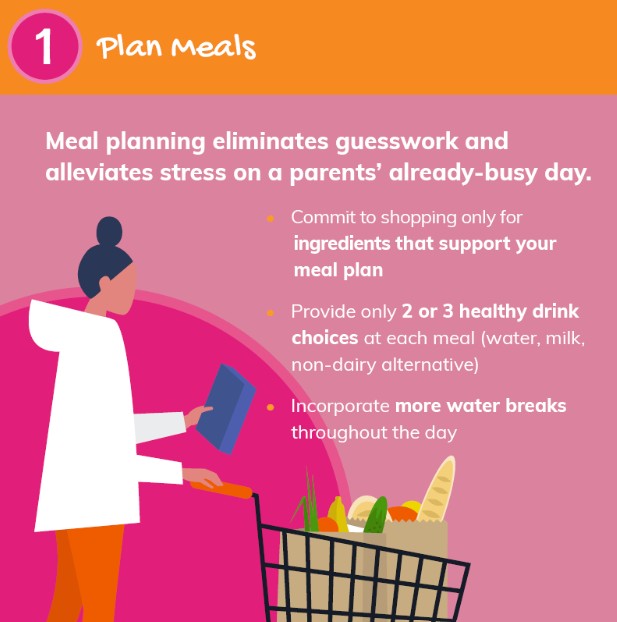
Deciding what to make for dinner is probably the last thing you want to do after balancing work, school, and increasing online demands. Meal planning can help take the guesswork out of dinner time and alleviate some stress on a parents’ already-busy day. While meal planning may seem overwhelming at first, it can help you pre-plan healthier meals and snack options for your children. When you commit to shopping for certain ingredients based on your menu, you might find you buy fewer sugary snacks, spend less, and create better meals.
One part of meal planning that can often be overlooked is what your family drinks. Try setting some rules around what drinks are allowed at breakfast, lunch, and dinner, and all the times in between. Incorporate more water breaks into the day. A way to encourage your children to drink more water is to lead by example. You may also want to provide only 2 or 3 healthy drink options at mealtimes so your children can choose for themselves. You’ll want to limit sugary drinks like soda, sports and fruit drinks.
2. Offering Healthy Choices for Your Kids
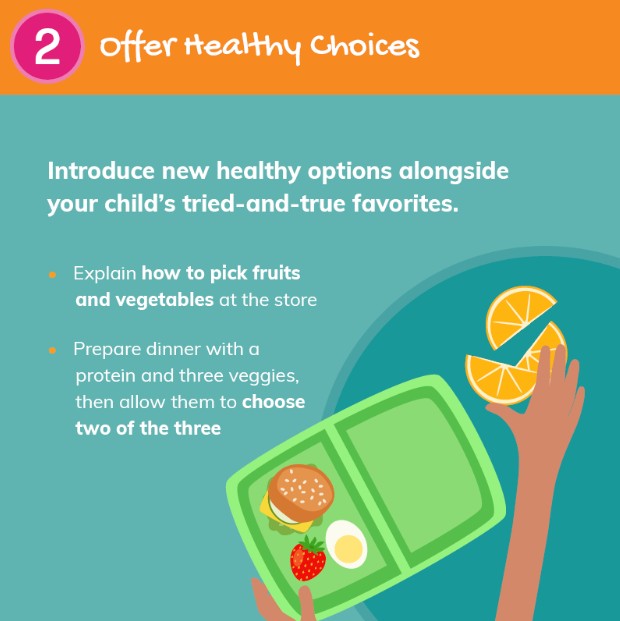
Providing your children with healthy choices and snacks is a great way to provide them with ownership over what they put in their body and encourage them to take more responsibility for their healthy habits. A meal plan with options helps your children establish their independence while keeping you, the parent, in control of their nutrition and healthy eating habits.
Incorporate a variety of healthy food options for your children, especially at a young age. Introduce new options alongside their tried-and-true favorites to encourage a positive association with healthy foods you think they will enjoy. As your children grow up, they are developing their own food preferences and tastes. Healthier options help them make better choices. This is also how you teach kids healthy eating habits. If your children are curious and interested, involve them in the selection process, like visiting the local farmer’s market and learning how to pick out certain types of fruits and vegetables.
3. Personalizing Your Child’s Plate
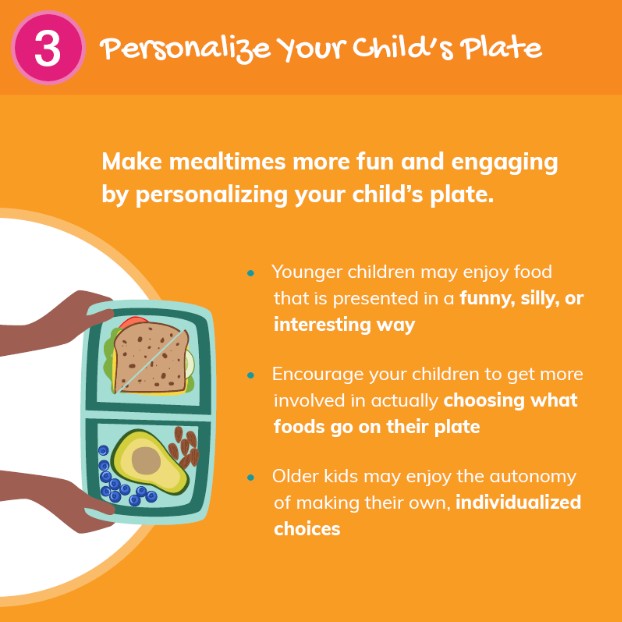
Another way to make mealtimes more fun and engaging is to personalize your child’s plate. Younger children may enjoy food that is presented in a funny, silly, or interesting way. Perhaps you celebrate certain holidays by arranging foods on the plate in a certain shape or character. This can keep kids engaged and interested in what they are about to eat. You can also encourage your children to get more involved in choosing what foods go on their plate. As children get older, they may enjoy the autonomy of making their own, individualized choices. You may prepare a dinner that involves a protein and three veggies, and then allow them to choose two of the three. A variety of healthy foods, including different flavors and textures, will help keep things exciting.
4. Avoiding Distractions During Mealtime
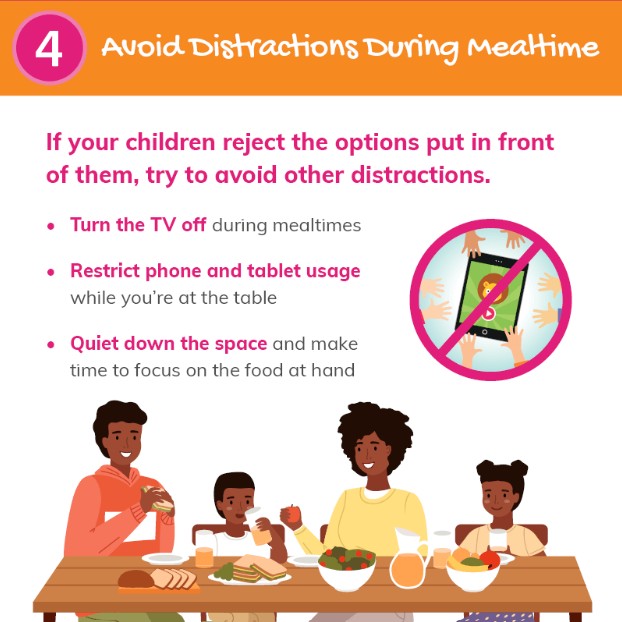
If your children still struggle with eating healthy and reject all the options put in front of them, you may also want to avoid other distractions. Reduce screen time – Turn the TV off during mealtimes and restrict phone and tablet usage while you’re at the table. Sometimes children get overstimulated by everything going on in the room and making decisions can feel overwhelming. Quiet down the space and make time to focus on the food at hand. Avoiding distractions during mealtime can also help children avoid overeating simply because they aren’t paying attention to whether their tummies are full or not. This can also provide more mindful eating where your child may notice more about the colors, flavors, and textures of the yummy foods they are eating. Reducing screen time can help free time for other activities and improve sleep.
5. Keeping Healthy Ingredients Around
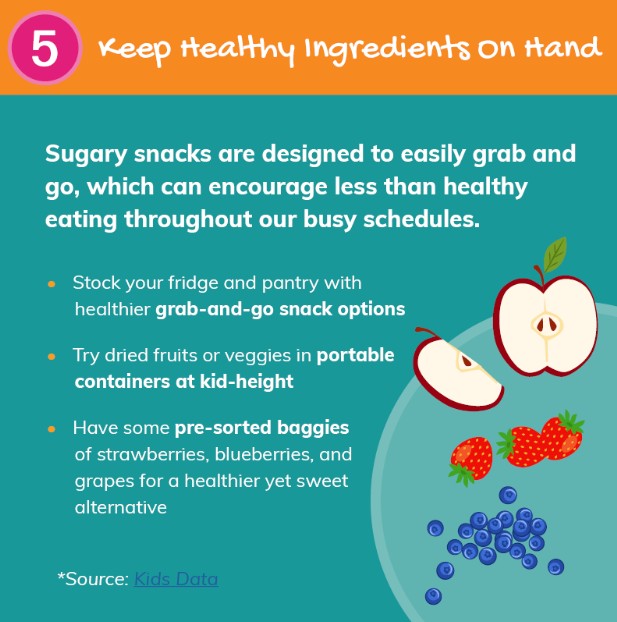
Many sugary snacks are designed to easily grab and go, which can encourage less than healthy eating throughout your busy schedule. With a little bit of planning and intentionality, you can choose to stock your fridge and pantry with healthier grab-and-go snack options that will promote healthier habits. Instead of cheesy crackers, try dried fruits or veggies in portable containers at kid-height in your pantry. Instead of sugary yogurts, perhaps have some pre-sorted baggies of strawberries, blueberries, and grapes for a healthier yet sweet alternative.
Resource:
>> Kids Data
Learn more about TrueCare pediatric services by texting or calling us today at (760) 736-6767. Or visit one of our many locations across North San Diego and South Riverside Counties.
DISCLAIMER: THIS WEBSITE DOES NOT PROVIDE MEDICAL ADVICE
The information, including but not limited to, text, graphics, images, and other material contained on this website are for informational purposes only. No material on this site is intended to be a substitute for professional medical advice, diagnosis, or treatment. Always seek the advice of your physician or other qualified health care with any questions you may have regarding a medical condition or treatment and before undertaking a new health care regimen, and never disregard professional medical advice or delay in seeking it because of something you read on this website.




